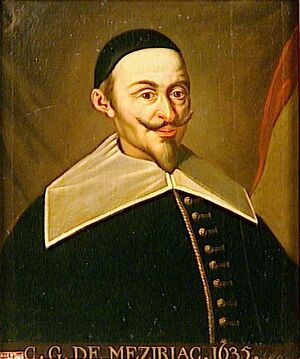Claude Gaspard Bachet de Méziriac (nonfiction): Difference between revisions
No edit summary |
No edit summary |
||
| Line 3: | Line 3: | ||
Bachet was a pupil of the Jesuit mathematician [[Jacques de Billy (nonfiction)|Jacques de Billy]] at the Jesuit College in Rheims. They became close friends. | Bachet was a pupil of the Jesuit mathematician [[Jacques de Billy (nonfiction)|Jacques de Billy]] at the Jesuit College in Rheims. They became close friends. | ||
Bachet wrote the ''Problèmes plaisants'', of which the first edition was issued in 1612, a second and enlarged edition was brought out in 1624; this contains an interesting collection of arithmetical tricks and questions, many of which are quoted in W. W. Rouse Ball's ''Mathematical Recreations and Essays''. | Bachet wrote the ''Problèmes plaisants'', of which the first edition was issued in 1612, a second and enlarged edition was brought out in 1624; this contains an interesting collection of arithmetical tricks and questions, many of which are quoted in [[W. W. Rouse Ball (nonfiction)|W. W. Rouse Ball]]'s ''Mathematical Recreations and Essays''. | ||
He also wrote ''Les éléments arithmétiques'', which exists in manuscript; and a translation, from Greek to Latin, of the ''Arithmetica'' of [[Diophantus (nonfiction)|Diophantus]] (1621). It was this very translation in which [[Pierre de Fermat (nonfiction)|Fermat]] wrote his famous margin note claiming that he had a proof of Fermat's last theorem. The same text renders Diophantus' term παρισὀτης as ''adaequalitat'', which became Fermat's technique of adequality, a pioneering method of infinitesimal calculus. | He also wrote ''Les éléments arithmétiques'', which exists in manuscript; and a translation, from Greek to Latin, of the ''Arithmetica'' of [[Diophantus (nonfiction)|Diophantus]] (1621). It was this very translation in which [[Pierre de Fermat (nonfiction)|Fermat]] wrote his famous margin note claiming that he had a proof of Fermat's last theorem. The same text renders Diophantus' term παρισὀτης as ''adaequalitat'', which became Fermat's technique of adequality, a pioneering method of infinitesimal calculus. | ||
| Line 21: | Line 21: | ||
== Fiction cross-reference == | == Fiction cross-reference == | ||
* [[Gnomon algorithm]] | |||
* [[Gnomon Chronicles]] | |||
* [[Mathematician]] | |||
* [[Mathematics]] | |||
== Nonfiction cross-reference == | == Nonfiction cross-reference == | ||
* [[Pierre de Fermat (nonfiction)]] | |||
* [[Mathematics (nonfiction)]] | * [[Mathematics (nonfiction)]] | ||
* [[ | * [[W. W. Rouse Ball (nonfiction)]] | ||
External links: | External links: | ||
Latest revision as of 16:24, 20 March 2018
Claude Gaspard Bachet de Méziriac (October 9, 1581 – February 26, 1638) was a French mathematician, linguist, poet and classics scholar born in Bourg-en-Bresse, at that time belonging to Duchy of Savoy.
Bachet was a pupil of the Jesuit mathematician Jacques de Billy at the Jesuit College in Rheims. They became close friends.
Bachet wrote the Problèmes plaisants, of which the first edition was issued in 1612, a second and enlarged edition was brought out in 1624; this contains an interesting collection of arithmetical tricks and questions, many of which are quoted in W. W. Rouse Ball's Mathematical Recreations and Essays.
He also wrote Les éléments arithmétiques, which exists in manuscript; and a translation, from Greek to Latin, of the Arithmetica of Diophantus (1621). It was this very translation in which Fermat wrote his famous margin note claiming that he had a proof of Fermat's last theorem. The same text renders Diophantus' term παρισὀτης as adaequalitat, which became Fermat's technique of adequality, a pioneering method of infinitesimal calculus.
Bachet was the earliest writer who discussed the solution of indeterminate equations by means of continued fractions.
He also did work in number theory and found a method of constructing magic squares.
Some sources also name him the founder of the Bézout's identity.
For a year in 1601 Bachet was a member of the Jesuit Order. He lived a comfortable life in Bourg-en-Bresse and married in 1612. He was elected member of the Académie française in 1635.
In the News
Fiction cross-reference
Nonfiction cross-reference
External links:
- Claude Gaspard Bachet de Méziriac @ Wikipedia
